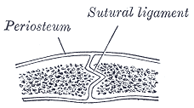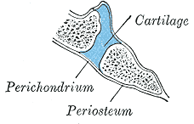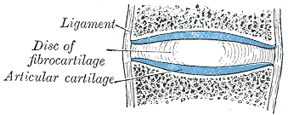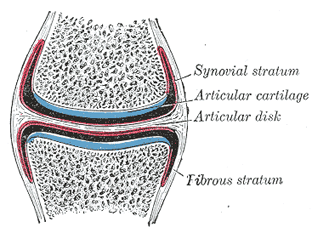 |
| FIG. 296– Section across the sagittal suture. |
|
| The articulations are divided into three classes: synarthroses or immovable, amphiarthroses or slightly movable, and diarthroses or freely movable, joints. |
| |
| Synarthroses (immovable articulations).—Synarthroses include all those articulations in which the surfaces of the bones are in almost direct contact, fastened together by intervening connective tissue or hyaline cartilage, and in which there is no appreciable motion, as in the joints between the bones of the skull, excepting those of the mandible. There are four varieties of synarthrosis: sutura, schindylesis, gomphosis, and synchondrosis. |
| |
| Sutura.—Sutura is that form of articulation where the contiguous margins of the bones are united by a thin layer of fibrous tissue; it is met with only in the skull (Fig. 296). When the margins of the bones are connected by a series of processes, and indentations interlocked together, the articulation is termed a true suture (sutura vera); and of this there are three varieties: sutura dentata, serrata, and limbosa. The margins of the bones are not in direct contact, being separated by a thin layer of fibrous tissue, continuous externally with the pericranium, internally with the dura mater. The sutura dentata is so called from the tooth-like form of the projecting processes, as in the suture between the parietal bones. In the sutura serrata the edges of the bones are serrated like the teeth of a fine saw, as between the two portions of the frontal bone. In the sutura limbosa, there is besides the interlocking, a certain degree of bevelling of the articular surfaces, so that the bones overlap one another, as in the suture between the parietal and frontal bones. When the articulation is formed by roughened surfaces placed in apposition with one another, it is termed a false suture (sutura notha), of which there are two kinds: the sutura squamosa, formed by the overlapping of contiguous bones by broad bevelled margins, as in the squamosal suture between the temporal and parietal, and the sutura harmonia, where there is simple apposition of contiguous rough surfaces, as in the articulation between the maxillæ, or between the horizontal parts of the palatine bones. |
| |
 |
| FIG. 297– Section through occipitosphenoid synchondrosis of an infant. |
| |
| |
| Schindylesis.—Schindylesis is that form of articulation in which a thin plate of bone is received into a cleft or fissure formed by the separation of two laminæ in another bone, as in the articulation of the rostrum of the sphenoid and perpendicular plate of the ethmoid with the vomer, or in the reception of the latter in the fissure between the maxillæ and between the palatine bones. |
| |
| Gomphosis.—Gomphosis is articulation by the insertion of a conical process into a socket; this is not illustrated by any articulation between bones, properly so called, but is seen in the articulations of the roots of the teeth with the alveoli of the mandible and maxillæ. |
| |
| Synchondrosis.—Where the connecting medium is cartilage the joint is termed a synchondrosis (Fig. 297). This is a temporary form of joint, for the cartilage is converted into bone before adult life. Such joints are found between the epiphyses and bodies of long bones, between the occipital and the sphenoid at, and for some years after, birth, and between the petrous portion of the temporal and the jugular process of the occipital. |
| |
| Amphiarthroses (slightly movable articulations). |
| —In these articulations the contiguous bony surfaces are either connected by broad flattened disks of fibrocartilage, of a more or less complex structure, as in the articulations between the bodies of the vertebræ; or are united by an interosseous ligament, as in the inferior tibiofibular articulation. The first form is termed a symphysis (Fig. 298), the second a syndesmosis. |
 |
| FIG. 298– Diagrammatic section of a symphysis. |
| |
| |
| Diarthroses (freely movable articulations).—This class includes the greater number of the joints in the body. In a diarthrodial joint the contiguous bony surfaces are covered with articular cartilage, and connected by ligaments lined by synovial membrane (Fig. 299). The joint may be divided, completely or incompletely, by an articular disk or meniscus, the periphery of which is continuous with the fibrous capsule while its free surfaces are covered by synovial membrane (Fig. 300). |
 |
| FIG. 299– Diagrammatic section of a diarthrodial joint. |
| |
 |
| FIG. 300– Diagrammatic section of a diarthrodial joint, with an articular disk. |
| |
| The varieties of joints in this class have been determined by the kind of motion permitted in each. There are two varieties in which the movement is uniaxial, that is to say, all movements take place around one axis. In one form, the ginglymus, this axis is, practically speaking, transverse; in the other, the trochoid or pivot-joint, it is longitudinal. There are two varieties where the movement is biaxial, or around two horizontal axes at right angles to each other, or at any intervening axis between the two. These are the condyloid and the saddle-joint. There is one form where the movement is polyaxial, the enarthrosis or ball-and-socket joint; and finally there are the arthrodia or gliding joints. |
| |
| Ginglymus or Hinge-joint.—In this form the articular surfaces are moulded to each other in such a manner as to permit motion only in one plane, forward and backward, the extent of motion at the same time being considerable. The direction which the distal bone takes in this motion is seldom in the same plane as that of the axis of the proximal bone; there is usually a certain amount of deviation from the straight line during flexion. The articular surfaces are connected together by strong collateral ligaments, which form their chief bond of union. The best examples of ginglymus are the interphalangeal joints and the joint between the humerus and ulna; the knee- and ankle-joints are less typical, as they allow a slight degree of rotation or of side-to-side movement in certain positions of the limb. |
| |
| Trochoid or Pivot-joint (articulatio trochoidea; rotary joint).—Where the movement is limited to rotation, the joint is formed by a pivot-like process turning within
a ring, or a ring on a pivot, the ring being formed partly of bone, partly of ligament. In the proximal radioulnar articulation, the ring is formed by the radial notch of the ulna and the annular ligament; here, the head of the radius rotates within the ring. In the articulation of the odontoid process of the axis with the atlas the ring is formed in front by the anterior arch, and behind by the transverse ligament of the atlas; here, the ring rotates around the odontoid process. |
| |
| Condyloid Articulation (articulatio ellipsoidea).—In this form of joint, an ovoid articular surface, or condyle, is received into an elliptical cavity in such a manner as to permit of flexion, extension, adduction, abduction, and circumduction, but no axial rotation. The wrist-joint is an example of this form of articulation. |
| |
| Articulation by Reciprocal Reception (articulatio sellaris; saddle-joint).—In this variety the opposing surfaces are reciprocally concavo-convex. The movements are the same as in the preceding form; that is to say, flexion, extension, adduction, abduction, and circumduction are allowed; but no axial rotation. The best example of this form is the carpometacarpal joint of the thumb. |
| |
| Enarthrosis (ball-and-socket joints).—Enarthrosis is a joint in which the distal bone is capable of motion around an indefinite number of axes, which have one common center. It is formed by the reception of a globular head into a cup-like cavity, hence the name “ball-and-socket.” Examples of this form of articulation are found in the hip and shoulder. |
| Arthrodia (gliding joints) is a joint which admits of only gliding movement; it is formed by the apposition of plane surfaces, or one slightly concave, the other slightly convex, the amount of motion between them being limited by the ligaments or osseous processes surrounding the articulation. It is the form present in the joints between the articular processes of the vertebræ, the carpal joints, except that of the capitate with the navicular and lunate, and the tarsal joints with the exception of that between the talus and the navicular. |





